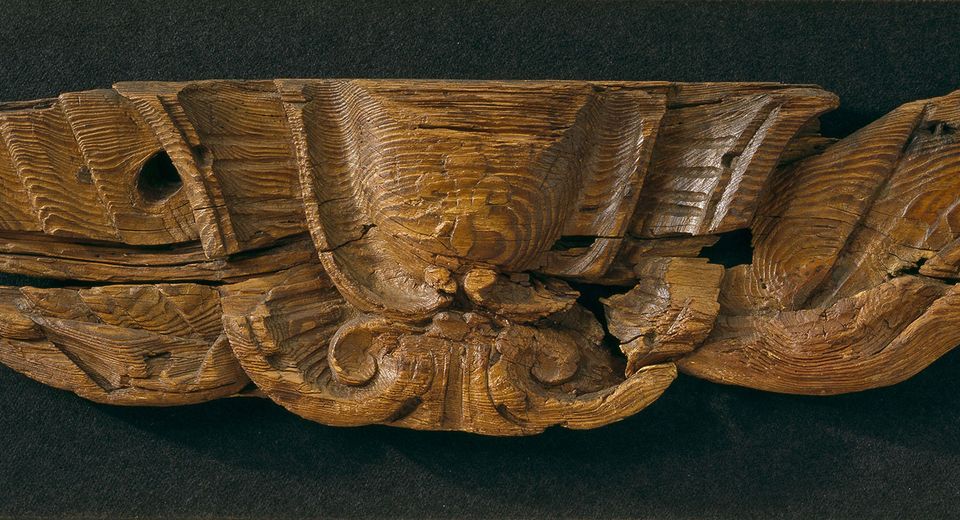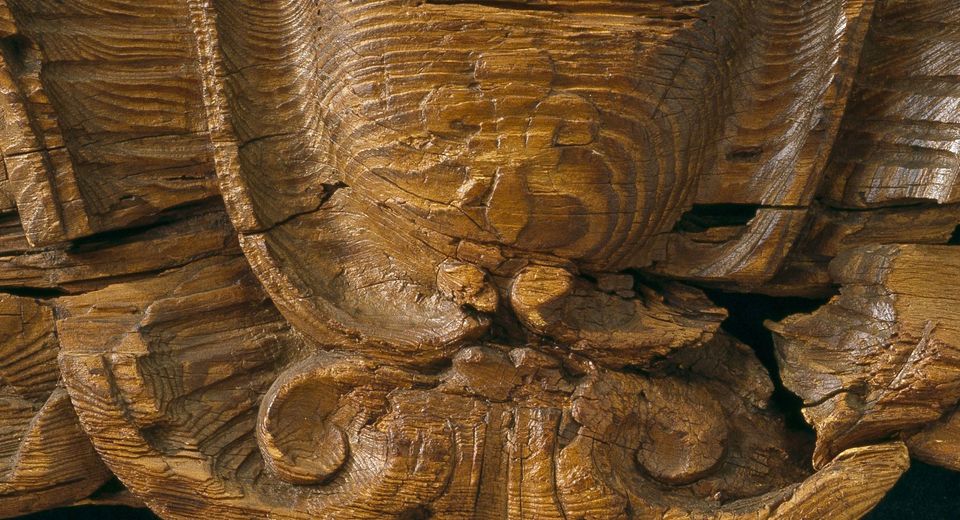Frigate’s coat of arms from the Lapérouse expedition
Brest
This piece of decoration is the only existing fragment of the expedition’s vessels, a testimony to their sinking. It bears the fleur-de-lys and was found by the Irish explorer Peter Dillon in the village of Ammah on Vanikoro island on 30 September 1827. It was being used to bar a front door. Dillon also found a bell in the village, along with a small bronze cannon, a copper cauldron and a millstone, items that bear witness to the Lapérouse expedition’s fate…
The Lapérouse expedition
Inspired by the voyages undertaken by England’s James Cook (1728-1779) and guided by Age of Enlightenment principles, Louis XVI entrusted a circumnavigation of the world to Jean-François Galaup de Lapérouse (1741-1788) in 1785. Under direct supervision from Versailles, preparations were made in Brest in the greatest possible secrecy. The two ships selected, the Boussole and the Astrolabe, were fitted out and provisioned for a four-year voyage. The expedition set out from Brest on 1 August 1785 with a crew of 220 men. An ambitious research programme was implemented by 17 scientists. The naturalist Dufresne, Father Receveur, naturalist and ship’s chaplain, and the physician and botanist Lamartinière studied animals and plants during stopovers. A King’s gardener, Jean-Nicolas Collignon, collected seeds and living shrubs. The astronomer Joseph Lepaute Dagelet carried out work on longitude. Engineers and physicists also took part in the adventure.
Lapérouse had maps made of the northwest coast of America and the northeast coast of Asia. In Alaska, they studied the possibility of setting up a fur-trading post in a bay they baptised “Port des Français”. Following a lengthy reconnoitre off the Siberian coast, Lapérouse mapped the Tartar Strait and discovered the strait that now bears his name, between Sakhalin and Japan. A tropical storm probably sank the two ships in May 1788.
What happened to the expedition?
In 1789, Lapérouse’s silence suggested that misfortune had struck. A search mission was entrusted to Bruny d’Entrecasteaux in 1791. It sailed past Vanikoro without stopping there. It was later discovered that some of the expedition’s members were still alive… In 1826, an Irish sailor by the name of Peter Dillon found a French sword guard on one of the Solomon Islands and collected oral testimonies from some of its inhabitants. Apparently, a last survivor had left Vanikoro less than three years before his arrival. Dillon pinpointed the position of the two wrecks and the survivors’ camp, and recovered numerous objects, including this fragment of one of the frigates.
In 1827, the French explorer Dumont d’Urville landed on Vanikoro in his turn. He collected more items and built a cenotaph to the memory of the crew.
The research missions
Further search missions were launched in the 1950s and 1960s. In 1981, The Solomon Islands Association started on a methodical land and sea excavation campaign that lasted until 2008. Discovery of remains of the survivors’ camp in the village of Paeu in 1999, and of the skeleton of the “Unknown Mariner from Vanikoro” in 2003 were the highlights of these operations. The discovery of scientific instruments in 2005 enabled identification of both wrecks. The Boussole, commanded by Lapérouse himself, had been cast on the reef’s outer fringes while the Astrolabe had run aground in a false passage.
The Unknown Mariner from Vanikoro
On 22 November 2003, members of the Solomon Islands Association found a skeleton aboard the wreck of the Boussole. Out of the human body’s 206 bones, only 8 vertebrae were missing along with the kneecaps and a few bones from the hands and feet. It was entrusted to the French National Gendarmerie Criminal Research Institute (IRCGN) for study and then to the CNRS’s Laboratory of Anthropology of Past Populations (LAPP). The skull is complete, with healthy, well maintained dentition. It belonged to a Caucasian man about thirty years old and an estimated 1.68 metres tall. After crosschecking with the muster roll and the place it was found, it could have belonged to Father Jean-André Mongez, the astronomer Joseph Lepaute Dagelet or the surgeon Jacques-Joseph Le Corre.
The Unknown Mariner from Vanikoro has been buried at Brest castle since 2011.
Collection highlight
The essential works to see during your visit to the Musée national de la Marine in Brest, Port-Louis, Rochefort, Toulon, and soon in Paris.


